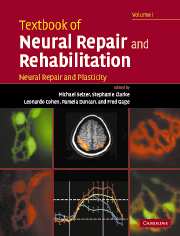Book contents
- Frontmatter
- Contents
- Contents (contents of Volume II)
- Preface
- Contributors (contributors of Volume I)
- Contributors (contributors of Volume II)
- Neural repair and rehabilitation: an introduction
- Section A Neural plasticity
- Section A1 Cellular and molecular mechanisms of neural plasticity
- 1 Anatomical and biochemical plasticity of neurons: regenerative growth of axons, sprouting, pruning, and denervation supersensitivity
- 2 Learning and memory: basic principles and model systems
- 3 Short-term plasticity: facilitation and post-tetanic potentiation
- 4 Long-term potentiation and long-term depression
- 5 Cellular and molecular mechanisms of associative and nonassociative learning
- Section A2 Functional plasticity in CNS system
- Section A3 Plasticity after injury to the CNS
- Section B1 Neural repair
- Section B2 Determinants of regeneration in the injured nervous system
- Section B3 Promotion of regeneration in the injured nervous system
- Section B4 Translational research: application to human neural injury
- Index
5 - Cellular and molecular mechanisms of associative and nonassociative learning
from Section A1 - Cellular and molecular mechanisms of neural plasticity
Published online by Cambridge University Press: 05 March 2012
- Frontmatter
- Contents
- Contents (contents of Volume II)
- Preface
- Contributors (contributors of Volume I)
- Contributors (contributors of Volume II)
- Neural repair and rehabilitation: an introduction
- Section A Neural plasticity
- Section A1 Cellular and molecular mechanisms of neural plasticity
- 1 Anatomical and biochemical plasticity of neurons: regenerative growth of axons, sprouting, pruning, and denervation supersensitivity
- 2 Learning and memory: basic principles and model systems
- 3 Short-term plasticity: facilitation and post-tetanic potentiation
- 4 Long-term potentiation and long-term depression
- 5 Cellular and molecular mechanisms of associative and nonassociative learning
- Section A2 Functional plasticity in CNS system
- Section A3 Plasticity after injury to the CNS
- Section B1 Neural repair
- Section B2 Determinants of regeneration in the injured nervous system
- Section B3 Promotion of regeneration in the injured nervous system
- Section B4 Translational research: application to human neural injury
- Index
Summary
Introduction
All animals have the capacity to adapt to environmental changes by modifying their behaviors. The experience-dependent modification of behavior is a manifestation of learning (which generally refers to the process of acquiring new information), whereas memory is the retention of learning over time. The neural mechanisms that contribute to the adaptation of an organism to environmental changes through learning are also likely to contribute to the adaptation of the organism to physical changes (e.g., trauma) through repair and rehabilitation. Some molecular mechanisms, such as neurotrophin signaling, second messenger cascades, transcription factor-mediated gene regulation, structural remodeling and growth, are likely sites of convergence between memory, development, and rehabilitation. Therefore, delineating the mechanisms that govern learning and memory could facilitate both the understanding of mechanisms that govern repair and rehabilitation, and the development of therapeutic pharmacological agents.
Four elementary forms of learning: habituation, sensitization, classical, and operant conditioning
Learning can be distinguished depending on whether it is associative or nonassociative. Nonassociative forms of learning include habituation and sensitization. Habituation is defined as the gradual waning of a behavioral response to a weak or moderate stimulus that is presented repeatedly. Following habituation, the response may be restored to its initial state either passively with time (i.e., spontaneous recovery), or with the presentation of a novel stimulus (i.e., dishabituation).
Keywords
- Type
- Chapter
- Information
- Textbook of Neural Repair and Rehabilitation , pp. 79 - 94Publisher: Cambridge University PressPrint publication year: 2006



